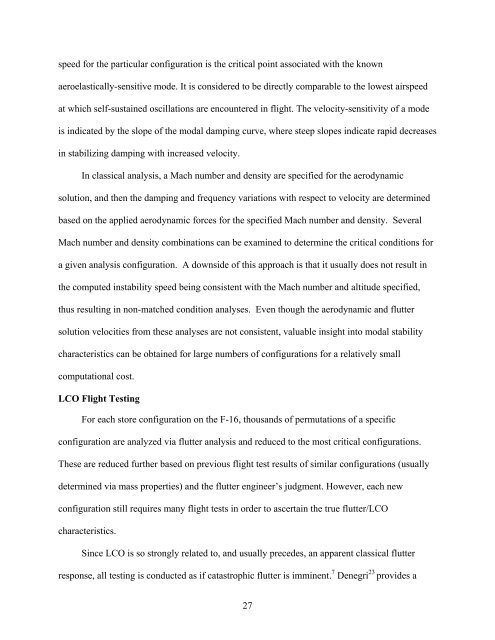university of florida thesis or dissertation formatting template
university of florida thesis or dissertation formatting template
university of florida thesis or dissertation formatting template
You also want an ePaper? Increase the reach of your titles
YUMPU automatically turns print PDFs into web optimized ePapers that Google loves.
speed f<strong>or</strong> the particular configuration is the critical point associated with the known<br />
aeroelastically-sensitive mode. It is considered to be directly comparable to the lowest airspeed<br />
at which self-sustained oscillations are encountered in flight. The velocity-sensitivity <strong>of</strong> a mode<br />
is indicated by the slope <strong>of</strong> the modal damping curve, where steep slopes indicate rapid decreases<br />
in stabilizing damping with increased velocity.<br />
In classical analysis, a Mach number and density are specified f<strong>or</strong> the aerodynamic<br />
solution, and then the damping and frequency variations with respect to velocity are determined<br />
based on the applied aerodynamic f<strong>or</strong>ces f<strong>or</strong> the specified Mach number and density. Several<br />
Mach number and density combinations can be examined to determine the critical conditions f<strong>or</strong><br />
a given analysis configuration. A downside <strong>of</strong> this approach is that it usually does not result in<br />
the computed instability speed being consistent with the Mach number and altitude specified,<br />
thus resulting in non-matched condition analyses. Even though the aerodynamic and flutter<br />
solution velocities from these analyses are not consistent, valuable insight into modal stability<br />
characteristics can be obtained f<strong>or</strong> large numbers <strong>of</strong> configurations f<strong>or</strong> a relatively small<br />
computational cost.<br />
LCO Flight Testing<br />
F<strong>or</strong> each st<strong>or</strong>e configuration on the F-16, thousands <strong>of</strong> permutations <strong>of</strong> a specific<br />
configuration are analyzed via flutter analysis and reduced to the most critical configurations.<br />
These are reduced further based on previous flight test results <strong>of</strong> similar configurations (usually<br />
determined via mass properties) and the flutter engineer’s judgment. However, each new<br />
configuration still requires many flight tests in <strong>or</strong>der to ascertain the true flutter/LCO<br />
characteristics.<br />
Since LCO is so strongly related to, and usually precedes, an apparent classical flutter<br />
response, all testing is conducted as if catastrophic flutter is imminent. 7 Denegri 23 provides a<br />
27
















